Java快速入门(三)
顺序结构
import java.util.Scanner;
public class Main {
public static void main(String[] args) {
var sc = new Scanner(System.in);
System.out.print("请输入姓名:");
String name = sc.nextLine();
System.out.printf("%n欢迎你:%s。\n", name);
System.out.print("请输入年龄:");
String age = sc.next();
System.out.println(age);
}
}
选择结构
- 选择结构:根据条件来选择性地执行某段代码
if 语句
- 语法结构
if (boolean 表达式 或 boolean 变量) {
// 条件结果为 true 时执行
// 条件执行体
}。
- 执行流程
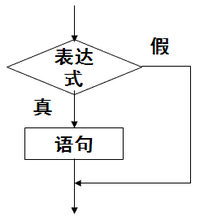 图 1 if语句
图 1 if语句
- if (boolean 表达式) 后没有
;
if-else 语句
-
语法结构
-
else 的隐含条件是对前面条件取反
if (boolean 表达式 或 boolean 变量) {
条件执行体 1 // 为 true 时执行
} else {
条件执行体 2 // 为 false 时执行
}
- 执行流程
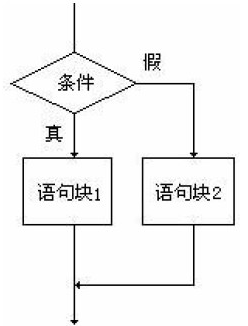
图 2 if-else语句
-
if-else 语句和三元运算符:从语义上二者的含义相同;从本质上说,if-else 是语句结构,三元运算符是一种运算符号,三元运算符运算结束后会得到一个结果,而 if-else,不能返回什么结果,只能控制语句的执行流程。
-
不能直接使用 else 语句.
if-else if-else 语句
- 语法结构
if (boolean 表达式 A) {
条件执行体 1 // A为 true 时执行
} else if (boolean 表达式 B) {
条件执行体 2 // B为 true 时执行
} else {
条件执行体 3 // 为 false 时执行}
- 执行流程
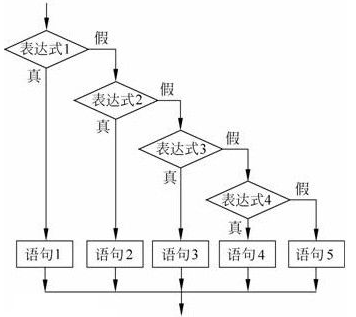
图 3 if-elseif-else语句
- 不能单独使用 else if
- 可以不需要 else,至少一个 else if
switch 语句
- 语法结构
switch (整型表达式) {
case 值 1:
执行语句 1;
break; // 注意是否要写 break
case 值 2:
执行语句 2;
break;
...
case 值 n:
执行语句 n;
break;
default:
以上值都不匹配时执行的语句;
// 不用写 break
}
- 执行流程
 图 4 if-elseif-else语句
图 4 if-elseif-else语句
- switch 语句适用于对多个整型值进行匹配判断,从而实现条件的分支控制,即“整型表达式 == int类型的值”
- switch 语句后的表达式的数据类型只能是 byte、short、char、int 四种整数类型,枚举类型和 String 类型(从 Java 7 才允许),不能是 boolean 类型
- switch 语句支持的基本数据类型只有四种:
byte、short、char、int,不支持 long 类型,本质:switch 仅仅只能支持 int 类型(byte、short、char 会自动提升为 int 类型) - switch 执行的时会把入口 case 之后的 case 统统忽略,会一直往下执行,直到遇到
break或return(穿透) default一般放在 switch 的最后,也不需要写 break
总结
- if 语句:针对单个条件判断
- if-else 语句:针对两个相斥条件判断
- if-else if-else 语句:针对多个相斥条件判断(
范围) - switch 语句:针对多个相斥条件判断(
整型值)
循环结构
- 循环结构:根据循环条件重复执行某段代码
- 定义对象、变量、获取数据库连接等操作尽量移至循环体外处理
while 循环
- 语法结构
while (boolean 表达式) {
循环体;
迭代语句;
// 自增或自减,用于对循环次数的控制
}
- 执行流程
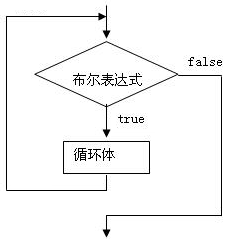
图 5 while循环
- while 循环特点:先判断表达式,若为 true 就执行循环体,否则,跳过循环体
- while 循环 和 do-while 循环 的循环体至少有 1 条语句用于对循环次数的控制(死循环除外)
do-while 循环
- 语法结构
do {
循环体;
迭代语句; // 自增或自减,用于对循环次数的控制
}
while (boolean 表达式);
- 执行流程
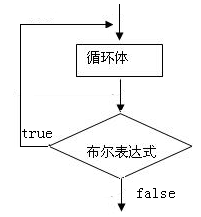
图 6 do-while循环
- do while 循环特点:先执行一次循环体,再判断表达式,若为 true 就执行循环体,否则,跳过循环体
- while 循环 和 do-while 循环 的循环体至少有 1 条语句用于对循环次数的控制(死循环除外)
for 循环
- 语法结构
for (初始化语句; boolean 表达式; 迭代语句) {
循环体;
}
- 执行流程
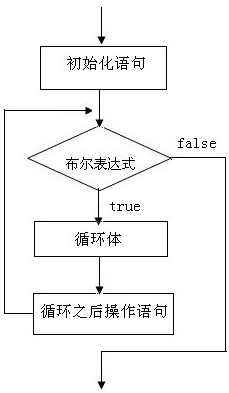
图 7 for循环
增强的for循环
增强的for循环是for循环的另一种形式。 它是 Java 5 中引入的,它是一种更简单的方法来迭代集合和数组的所有元素。 它可以使您的循环更紧凑,更易于阅读。
增强的for循环语法
for(DataType obj: array/collection){
// obj 从容器中按顺序获取元素
}
增强的for循环示例
import java.util.Arrays;
import java.util.List;
public class for_loop {
public static void main(String[] args) {
//enhanced for loop
String[] array = {"Hello ", "Hi ", "How ", "are ", "you?"};
List<String> list = Arrays.asList(array);
for (String str : array) {
System.out.print(str);
}
System.out.println("\n");
for (String str : list) {
System.out.print(str);
}
}
}
上面代码的输出是
Hello Hi How are you?
Hello Hi How are you?
增强了循环遍历给定集合或数组中的每个对象,将对象存储在变量中和执行循环的主体。
建议尽可能使用增强的for循环。
在增强的 for 循环中找不到当前索引。 在需要索引号的情况下,可以使用旧的for循环,也可以尝试以下替代方法来获取索引号。
import java.util.Arrays;
import java.util.List;
public class for_loop {
public static void main(String[] args) {
//enhanced for loop
String[] array = {"Hello ", "Hi ", "How ", "are ", "you?"};
List<String> list = Arrays.asList(array);
int index = 0;
for (String str : array) {
System.out.print(str);
System.out.println("Current Index :" + index++);
}
System.out.println("\n");
for (String str : list) {
System.out.print(str);
System.out.println("Current Index: " + list.indexOf(str));
}
}
}
代码输出
Hello Current Index :0
Hi Current Index :1
How Current Index :2
are Current Index :3
you?Current Index :4
Hello Current Index: 0
Hi Current Index: 1
How Current Index: 2
are Current Index: 3
you?Current Index: 4
死循环
while (true) {
}do {}
while (true)
for ( ; ; ) {}
循环选择
- 事先不知道循环次数,使用 while 循环或 do-while 循环,至少执行一次使用 do-while 循环
- 事先知道循环次数,优先使用 for 循环
- 死循环,推荐使用 while 循环
嵌套循环
- 重复的操作(内层循环) 需要做 N 次(外层循环)
- 确定:循环的是什么,要循环的次数
- 嵌套 for 循环性能优化:
- 将循环变量的声明放在循环外
- 将循环次数少的作为外层循环
循环控制
break:结束当前 break 所在的整个循环continue:跳过 continue 所在的本次循环剩下语句,开始下一次循环return:结束 return 所在的方法- 控制外层循环
- 在外层循环开始前使用标签标识一个外层循环,如 outer:
- 在 break 或 continue 后紧跟标签名,如 break outer; 或 continue outer;
- 三者相同点:在其后不能写语句(这个语句与其在同一个花括号中),否则编译报错
案例
例1:打印金字塔
public class Main {
public static void main(String[] args) {
int lay = 10;
for (int i = 1; i <= lay; i++) {
for (int j = 1; j <= lay - i; j++) {
System.out.print(" ");
}
for (int k = 1; k <= i * 2 - 1; k++) {
System.out.print("*");
}
System.out.println();
}
}
}
结果:
*
***
*****
*******
*********
***********
*************
***************
*****************
*******************
例2:打印空金字塔
public class Main {
public static void main(String[] args) {
int lay = 10;
for (int i = 1; i <= lay; i++) {
for (int j = 1; j <= lay - i; j++) {
System.out.print(" ");
}
for (int k = 1; k <= i * 2 - 1; k++) {
if (i == 1 || i == lay) {
System.out.print("*");
} else {
if (k == 1 || k == i * 2 - 1) {
System.out.print("*");
} else {
System.out.print(" ");
}
}
}
System.out.println();
}
}
}
结果:
*
* *
* *
* *
* *
* *
* *
* *
* *
*******************
例3: 数值比较与奇偶判断
/*
if语句格式2的练习:
A:获取两个数据中较大的值
B:判断一个数据是奇数还是偶数,并输出是奇数还是偶数
*/
import java.util.Scanner;
public class Main {
public static void main(String[] args) {
//创建键盘录入对象
Scanner sc = new Scanner(System.in);
//获取两个数据中较大的值
System.out.println("请输入第一个数据:");
int a = sc.nextInt();
System.out.println("请输入第二个数据:");
int b = sc.nextInt();
//定义一个变量接收最大值
int max;
if (a > b) {
max = a;
} else {
max = b;
}
System.out.println("max:" + max);
System.out.println("----------------");
//判断一个数据是奇数还是偶数
System.out.println("请输入你要判断的数据:");
int x = sc.nextInt();
if (x % 2 == 0) {
System.out.println(x + "这个数据是偶数");
} else {
System.out.println(x + "这个数据是奇数");
}
}
}
例4: 水仙花数
/*
需求:在控制台输出所有的”水仙花数”
分析:
我们都不知道什么叫"水仙花数",你让我怎么做呢?
所谓的水仙花数是指一个三位数,其各位数字的立方和等于该数本身。
举例:153就是一个水仙花数。
153 = 1*1*1 + 5*5*5 + 3*3*3 = 1 + 125 + 27 = 153
A:三位数其实是告诉了我们范围。
B:通过for循环我们就可以实现获取每一个三位数
但是麻烦是如何获取这个三位数的个,十,百位上的数据
我们如何获取一个数据的个,十,百呢?
假设有个一个数据:153
ge: 153%10 = 3
shi: 153/10%10 = 5
bai:153/10/10%10 = 1
qian:x/10/10/10%10
wan: x/10/10/10/10%10
...
C:让ge*ge*ge+shi*shi*shi+bai*bai*bai和该数据比较
如果相同,就把该数据在控制台输出。
*/
public class Main {
public static void main(String[] args) {
// 三位数其实是告诉了我们范围。
for (int x = 100; x < 1000; x++) {
int ge = x % 10;
int shi = x / 10 % 10;
int bai = x / 10 / 10 % 10;
// 让ge*ge*ge+shi*shi*shi+bai*bai*bai和该数据比较
if (x == (ge * ge * ge + shi * shi * shi + bai * bai * bai)) {
// 如果相同,就把该数据在控制台输出。
System.out.println(x);
}
}
}
}
例5: 求出1-100之和
/*
求出1-100之和
*/
public class Main {
public static void main(String[] args) {
//求出1-100之和
//for语句版本
int sum = 0;
for (int x = 1; x <= 100; x++) {
sum += x;
}
System.out.println("sum:" + sum);
System.out.println("--------");
//while语句版本
int sum2 = 0;
int y = 1;
while (y <= 100) {
sum2 += y;
y++;
}
System.out.println("sum2:" + sum2);
System.out.println("--------");
}
}
例6: 99乘法表
public class Main {
public static void main(String[] args) {
for (int x = 1; x <= 9; x++) {
for (int y = 1; y <= x; y++) {
System.out.print(y + "*" + x + "=" + y * x + "\t");
}
System.out.println();
}
}
}
1*1=1
1*2=2 2*2=4
1*3=3 2*3=6 3*3=9
1*4=4 2*4=8 3*4=12 4*4=16
1*5=5 2*5=10 3*5=15 4*5=20 5*5=25
1*6=6 2*6=12 3*6=18 4*6=24 5*6=30 6*6=36
1*7=7 2*7=14 3*7=21 4*7=28 5*7=35 6*7=42 7*7=49
1*8=8 2*8=16 3*8=24 4*8=32 5*8=40 6*8=48 7*8=56 8*8=64
1*9=9 2*9=18 3*9=27 4*9=36 5*9=45 6*9=54 7*9=63 8*9=72 9*9=81